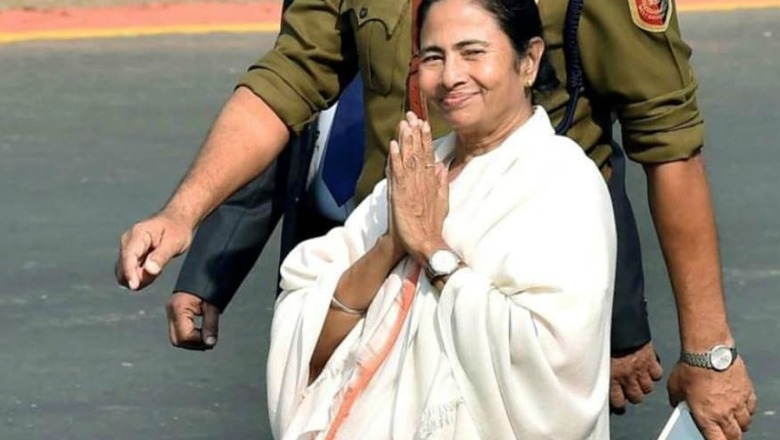
views
"It was my constitutional obligation...bhul bujhben na (don't misunderstand me)," said West Bengal chief minister Mamata Banerjee, with folded hands, on January 11, 2020.
This transformation of the Trinamool Congress (TMC) chief, from a firebrand leader to a polite politician, surprised the protesters who asked what forced her to meet Prime Minister Narendra Modi at Kolkata's Raj Bhawan despite being one his strongest critics.
That day, after meeting PM Modi, Mamata went to Esplanade to attend a public event against the National Register of Citizens (NRC) and the Citizenship Amendment Act (CAA) where she came across a group of Left agitators who accused her of having a secret political understanding with the Bharatiya Janata Party (BJP).
“Please don’t get me wrong...it was my constitutional obligation to meet him,” she said with folded hands amid slogans of "Go back Didi, go back Modi".
Many in the TMC and even some in the opposition camps felt that it was her ‘masterstroke’. They said if it would have been the "old angry Didi", then they would have been chased away by the police and that would have been seen as a "strategic blunder" by Mamata.
A few days later, she quietly implemented a system-driven assessment plan in the Trinamool Congress to identify non-performing assets, corrupt party leaders, and assess leaders in real time.
The TMC also introduced barcoded invitation cards for party leaders, workers, cadres which will work as access cards to attend party meetings and events, especially those which will be addressed/chaired by the party chief herself.
The barcoded invitation card was a well-thought move to figure out the number of absentees in a party meet. Invitation cards powered with barcodes were used for the first time at Mamata’s mega party meet on municipal polls at Netaji Indoor Stadium on March 2, 2020.
While Mamata was silently working on system-driven assessment, her office was already flooded with a number of grievance messages. This was courtesy the ‘Didi Ke Bolo’ platform (where people can directly take their grievances to the chief minister’s office through toll-free numbers) launched by her on July 29, 2019.
She publicly warned party leaders to stay away from any malpractices and even asked them to leave the party if they didn’t want to serve the people. “There is no place for such leaders who are involved in malpractice,” she said.
Hundreds of party workers, leaders, panchayat pradhans were asked to return ‘cut money’, ration dealers were arrested/show-caused for their involvement in rampant corruption.
Surprisingly, in the last three months more than 350 party cadres, including 200 from East Midnapore’s Nandigram were issued show-cause notices, mainly over malpractices during Cyclone Amphan.
They were asked to return public money within a few days or the party would lodge police complaints against them.
Senior MP and TMC East Midnapore district president Sisir Adhikari said, “Some people are actively involved in corruption out of greed. A section of them have started returning people’s welfare money. The party has taken strong action against them.”
Commenting on allegations of malpractices across the state by some party leaders, TMC secretary general Partha Chatterjee said, “Not only in Nandigram, this process is going on across the state. Only show-cause and expulsions will not solve the problem, we are also planning to take punitive measures against them as per law.”
In the last seven months, there are telltale signs of things changing in the "new TMC" with a definite plan and script considering the crucial upcoming 2021 assembly polls in the state.
With no slips of tongue and ‘strikingly’ missing key leaders (at least in the front rows) when Mamata participated in anti-NRC, CAA rallies with common people instead across Kolkata in recent months— before the Covid-19 crisis— it drew the attention of political experts.
“TMC has taken many image makeover initiatives considering the upcoming state polls. Even the state CM has also changed her tone while responding to opposition leaders and the central ministers. It is clear that she (Mamata) has realised that people are angry at the ground level over corruption and ‘cut money’ issues. Therefore, in recent months hundreds of party cadres were sidelined and were punished. This is a simple image makeover and I think these initiatives are the brainchild of Prashant Kishor,” author and political expert Kapil Thakur said.
It was learnt that the party MLAs, local leaders, booth presidents and district presidents were asked to submit reports on days they spent in their respective constituencies and what welfare work they have done for the people.
They were also told by Mamata to perform or perish as there is no dearth of youngsters and newcomers who are eager to work for the TMC.
State BJP president Dilip Ghosh said, “Why is the ruling party reluctant to lodge FIRs against the corrupt TMC leaders? If they know the culprits, why are they delaying in taking serious action against them?”
CPI(M) legislator Sujan Chakraborty demanded that the name of the accused TMC leaders/workers should be made public for better transparency.
It is not hidden to anyone that May 23, 2019 results of the parliamentary polls had proved Mamata's worst fears true. The made massive gains in West Bengal, winning 18 of the state’s 42 Lok Sabha seats, up from just two in 2014.
While the TMC was on the back foot, Mamata worked hard to cleanse the party to get it on track, especially in the backwoods to sweep the 2021 Assembly Polls with full majority.
Among many instructions, Mamata asked party leaders/workers/cadres to ‘visibly change their lifestyle’, which includes shunning luxury cars, giving contractual jobs to relatives, expensive gadgets, no to violence and hobnobbing with the district administration.
“Ever since Mamata roped in Prashant Kishor, the poll strategist has given a complete makeover to the TMC supremo. This is a much-needed reform for Trinamool considering the rise of the BJP, and now even the Left Front is working hard on the ground to increase its vote share,” said Kapil Thakur.
In the 2016 assembly polls, the BJP’s vote share was 10.2 per cent and in the 2019 Lok Sabha elections it went up to 40.3 per cent. There was an increase of 30.1 percentage point in vote share mainly because of Hindus gravitating towards the BJP. In the last three years, the BJP has managed to cultivate religion-driven politics in Bengal and it was evident with its significant rise in Bengal in terms of it’s vote share.
An analysis from the 2011 and 2016 assembly polls says the Left Front lost its vote share by 9.88 per cent and from 2014 to 2019 Lok Sabha elections its vote share further plummeted to nearly 16 per cent.
However, the Congress vote share from 2011 to 2016 assembly polls increased from 8.91 per cent to 12.3 per cent, but it fell drastically in the 2014 Lok Sabha polls (9.6 %) while in 2019 general elections the party managed to secure only 5 per cent votes.
It was further noted that these votes (most of them) which were once with the Left Front and Congress went to the BJP as there was no decline in the TMC’s vote share. In the 2011 assembly polls, the TMC’s vote share was 39 per cent which then increased to 39.56 per cent.
Similarly, in the 2014 Lok Sabha polls, TMC’s vote share was 39.03 per cent which then increased to 43.3 per cent. As per statistics, the only factor which went in favour of the BJP is the Left and the Congress vote.
“So, considering the present political situation (though it’s a bit too early), the rise of the Left in Bengal means trouble for BJP,” Thakur said.
With a series of reforms in the party, the TMC supremo has decided to sound the poll bugle through her virtual address to the people on ‘Shahid Diwas’ (Martyr’s Day) on July 21. On July 3, she already had a virtual meeting with party leaders and sent a strong message that there is no place for non-performers in the party and those who are working must win their assembly seats.


















Comments
0 comment